warning GENESIS G90 2017 User Guide
[x] Cancel search | Manufacturer: GENESIS, Model Year: 2017, Model line: G90, Model: GENESIS G90 2017Pages: 524, PDF Size: 19.3 MB
Page 29 of 524
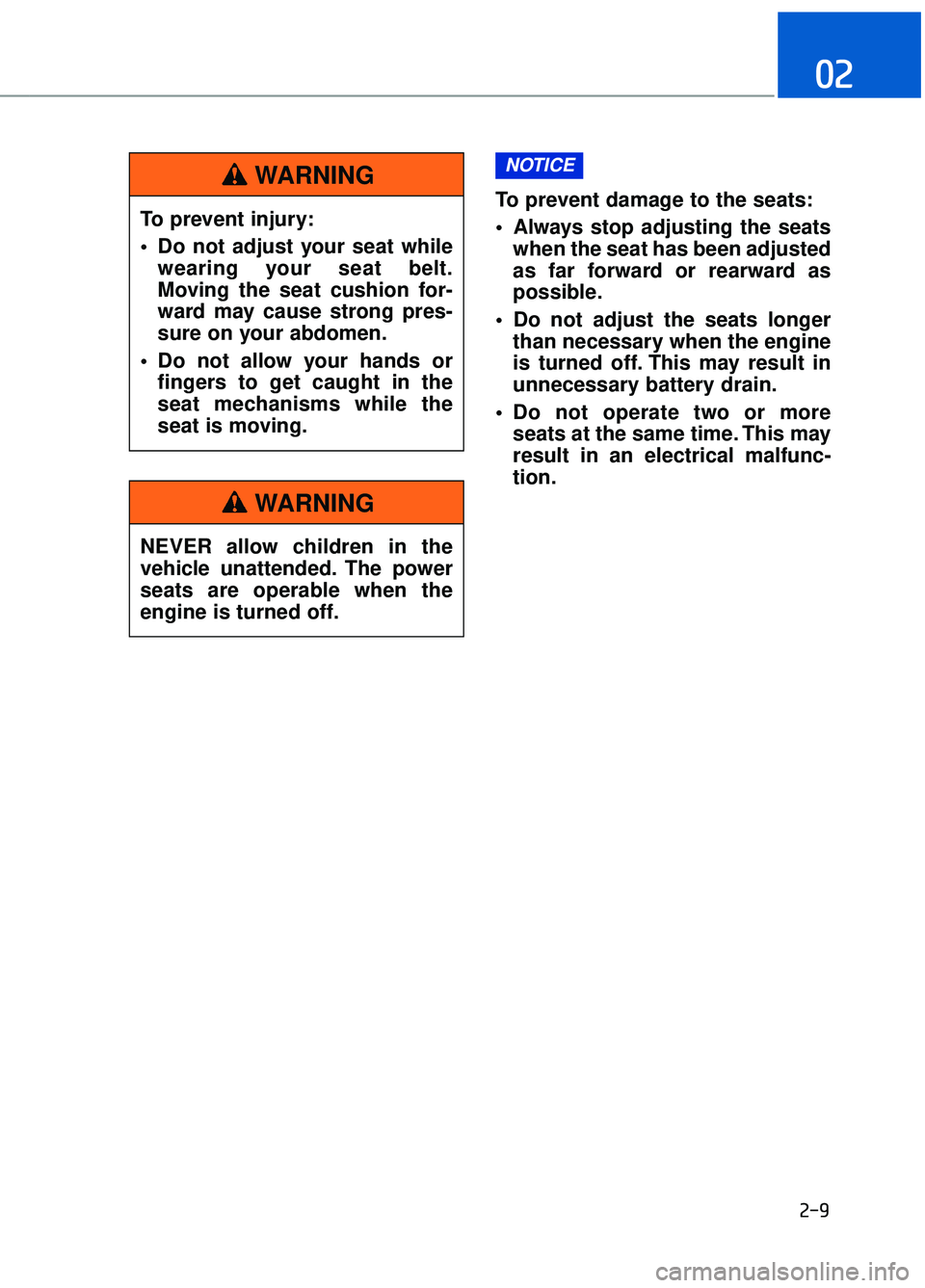
2-9
02
To prevent damage to the seats:
Always stop adjusting the seatswhen the seat has been adjusted
as far forward or rearward as
possible.
Do not adjust the seats longer than necessary when the engine
is turned off. This may result in
unnecessary battery drain.
Do not operate two or more seats at the same time. This may
result in an electrical malfunc-
tion.
NOTICE
To prevent injury:
Do not adjust your seat whilewearing your seat belt.
Moving the seat cushion for-
ward may cause strong pres-
sure on your abdomen.
Do not allow your hands or fingers to get caught in the
seat mechanisms while the
seat is moving.
WARNING
NEVER allow children in the
vehicle unattended. The power
seats are operable when the
engine is turned off.
WARNING
Page 31 of 524
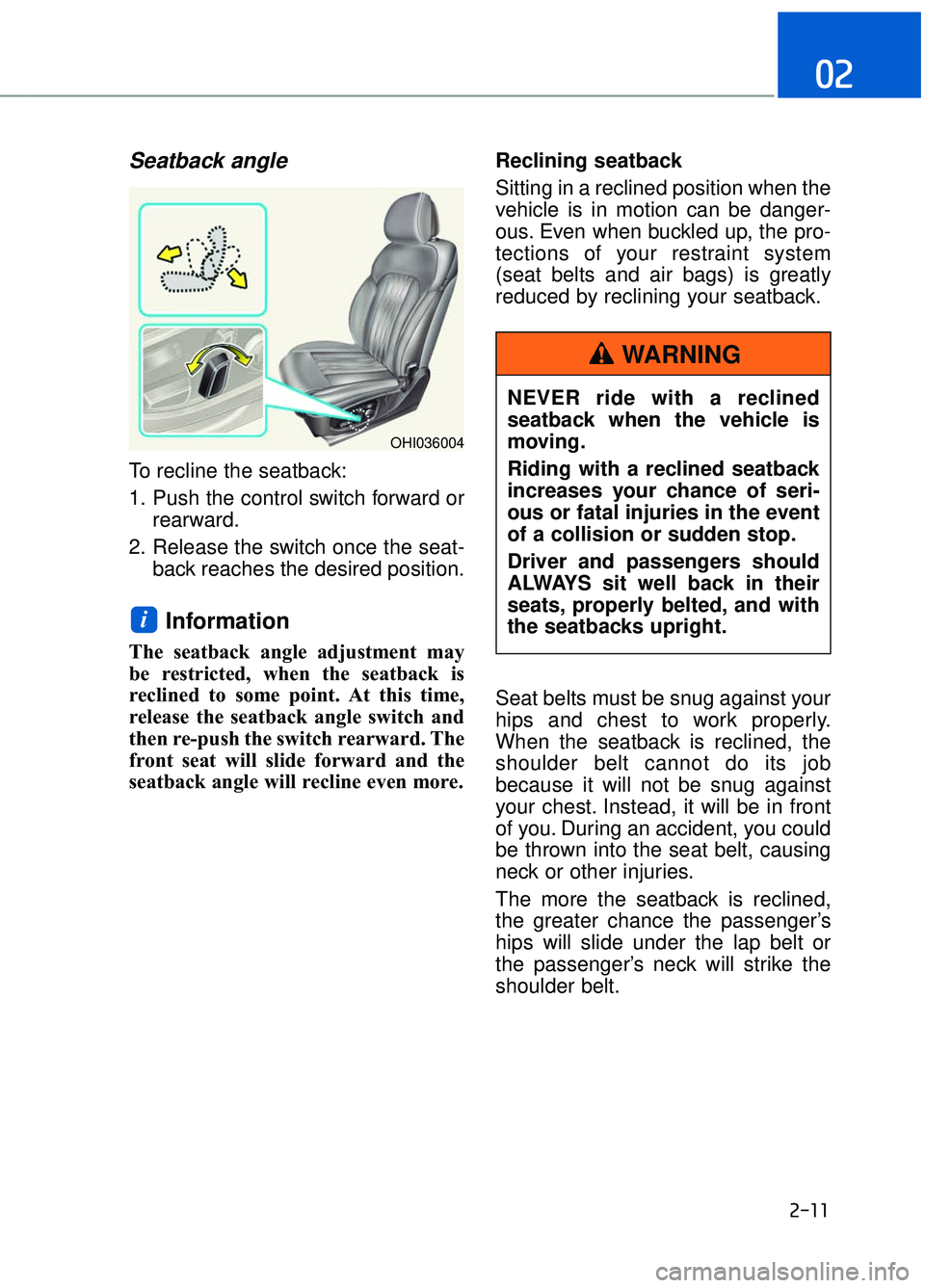
2-11
02
Seatback angle
To recline the seatback:
1. Push the control switch forward orrearward.
2. Release the switch once the seat- back reaches the desired position.
Information
The seatback angle adjustment may
be restricted, when the seatback is
reclined to some point. At this time,
release the seatback angle switch and
then re-push the switch rearward. The
front seat will slide forward and the
seatback angle will recline even more. Reclining seatback
Sitting in a reclined position when the
vehicle is in motion can be danger-
ous. Even when buckled up, the pro-
tections of your restraint system
(seat belts and air bags) is greatly
reduced by reclining your seatback.
Seat belts must be snug against your
hips and chest to work properly.
When the seatback is reclined, the
shoulder belt cannot do its job
because it will not be snug against
your chest. Instead, it will be in front
of you. During an accident, you could
be thrown into the seat belt, causing
neck or other injuries.
The more the seatback is reclined,
the greater chance the passenger’s
hips will slide under the lap belt or
the passenger’s neck will strike the
shoulder belt.
i
OHI036004
NEVER ride with a reclined
seatback when the vehicle is
moving.
Riding with a reclined seatback
increases your chance of seri-
ous or fatal injuries in the event
of a collision or sudden stop.
Driver and passengers should
ALWAYS sit well back in their
seats, properly belted, and with
the seatbacks upright.
WARNING
Page 34 of 524
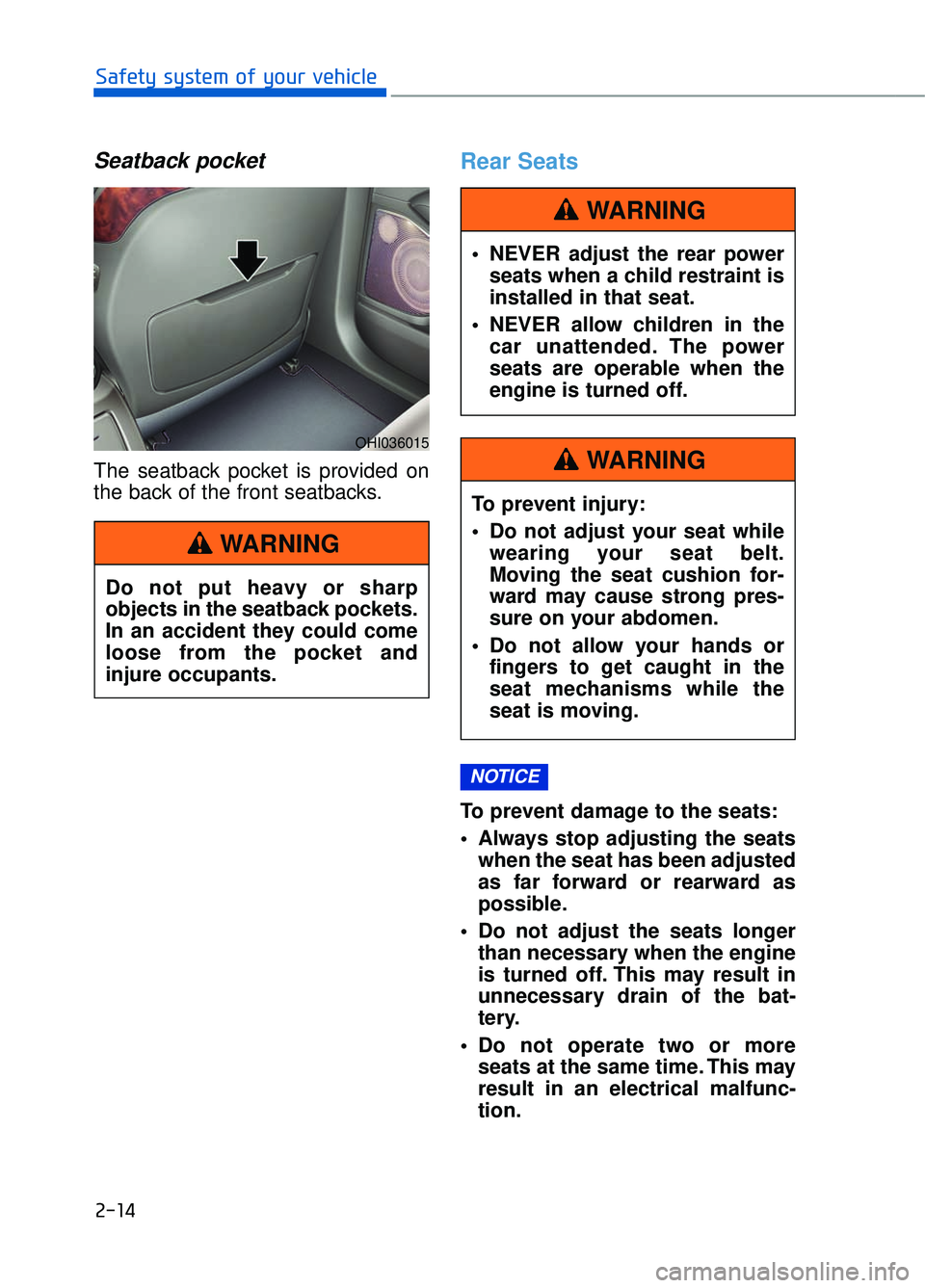
2-14
Safety system of your vehicle
Seatback pocket
The seatback pocket is provided on
the back of the front seatbacks.
Rear Seats
To prevent damage to the seats:
Always stop adjusting the seatswhen the seat has been adjusted
as far forward or rearward as
possible.
Do not adjust the seats longer than necessary when the engine
is turned off. This may result in
unnecessary drain of the bat-
tery.
Do not operate two or more seats at the same time. This may
result in an electrical malfunc-
tion.
NOTICE
NEVER adjust the rear powerseats when a child restraint is
installed in that seat.
NEVER allow children in the car unattended. The power
seats are operable when the
engine is turned off.
WARNING
To prevent injury:
Do not adjust your seat whilewearing your seat belt.
Moving the seat cushion for-
ward may cause strong pres-
sure on your abdomen.
Do not allow your hands or fingers to get caught in the
seat mechanisms while the
seat is moving.
WARNING
OHI036015
Do not put heavy or sharp
objects in the seatback pockets.
In an accident they could come
loose from the pocket and
injure occupants.
WARNING
Page 36 of 524
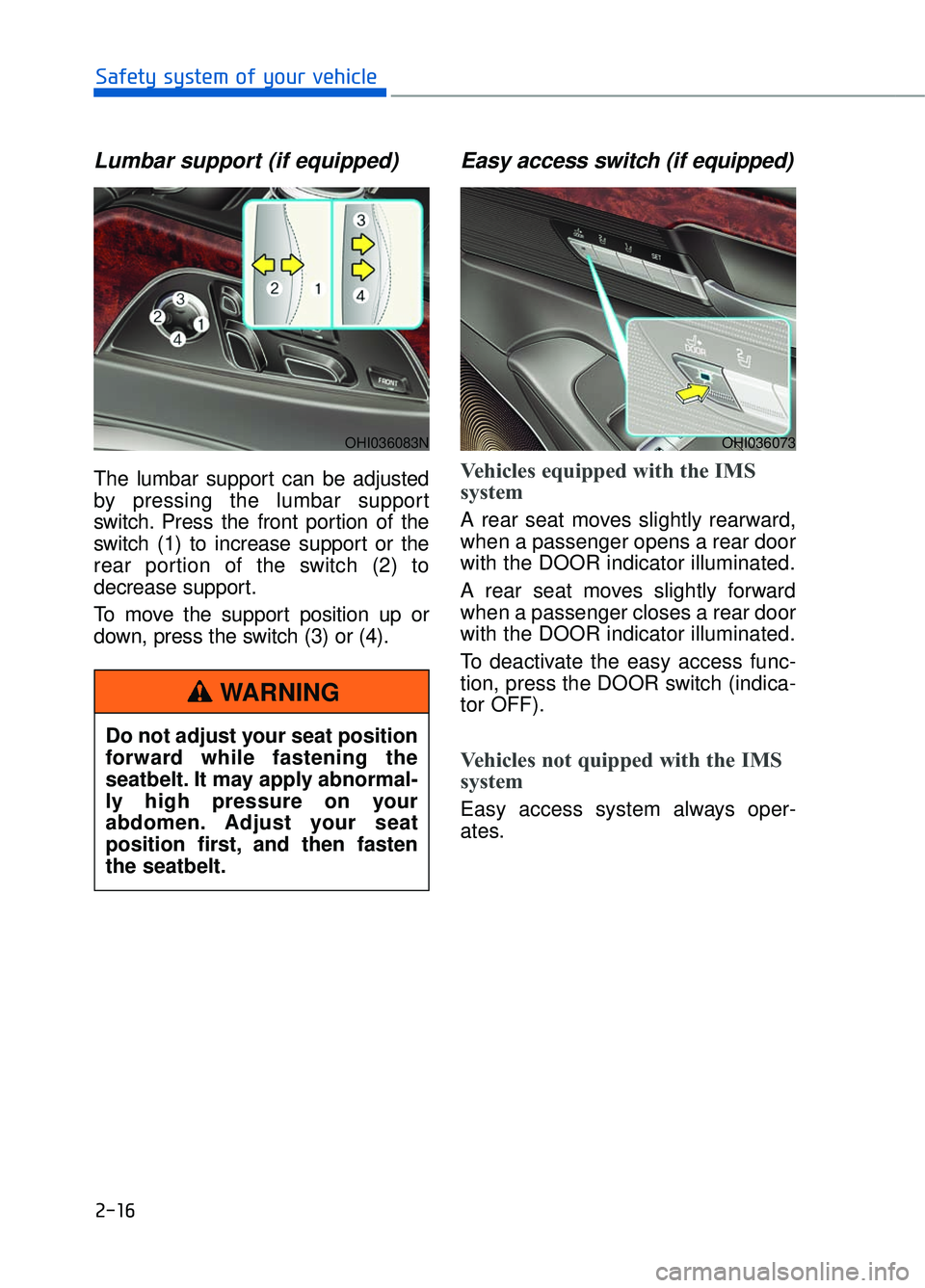
2-16
Safety system of your vehicle
Lumbar support (if equipped)
The lumbar support can be adjusted
by pressing the lumbar support
switch. Press the front portion of the
switch (1) to increase support or the
rear portion of the switch (2) to
decrease support.
To move the support position up or
down, press the switch (3) or (4).
Easy access switch (if equipped)
Vehicles equipped with the IMS
system
A rear seat moves slightly rearward,
when a passenger opens a rear door
with the DOOR indicator illuminated.
A rear seat moves slightly forward
when a passenger closes a rear door
with the DOOR indicator illuminated.
To deactivate the easy access func-
tion, press the DOOR switch (indica-
tor OFF).
Vehicles not quipped with the IMS
system
Easy access system always oper-
ates.
Do not adjust your seat position
forward while fastening the
seatbelt. It may apply abnormal-
ly high pressure on your
abdomen. Adjust your seat
position first, and then fasten
the seatbelt.
WARNING
OHI036083NOHI036073
Page 37 of 524
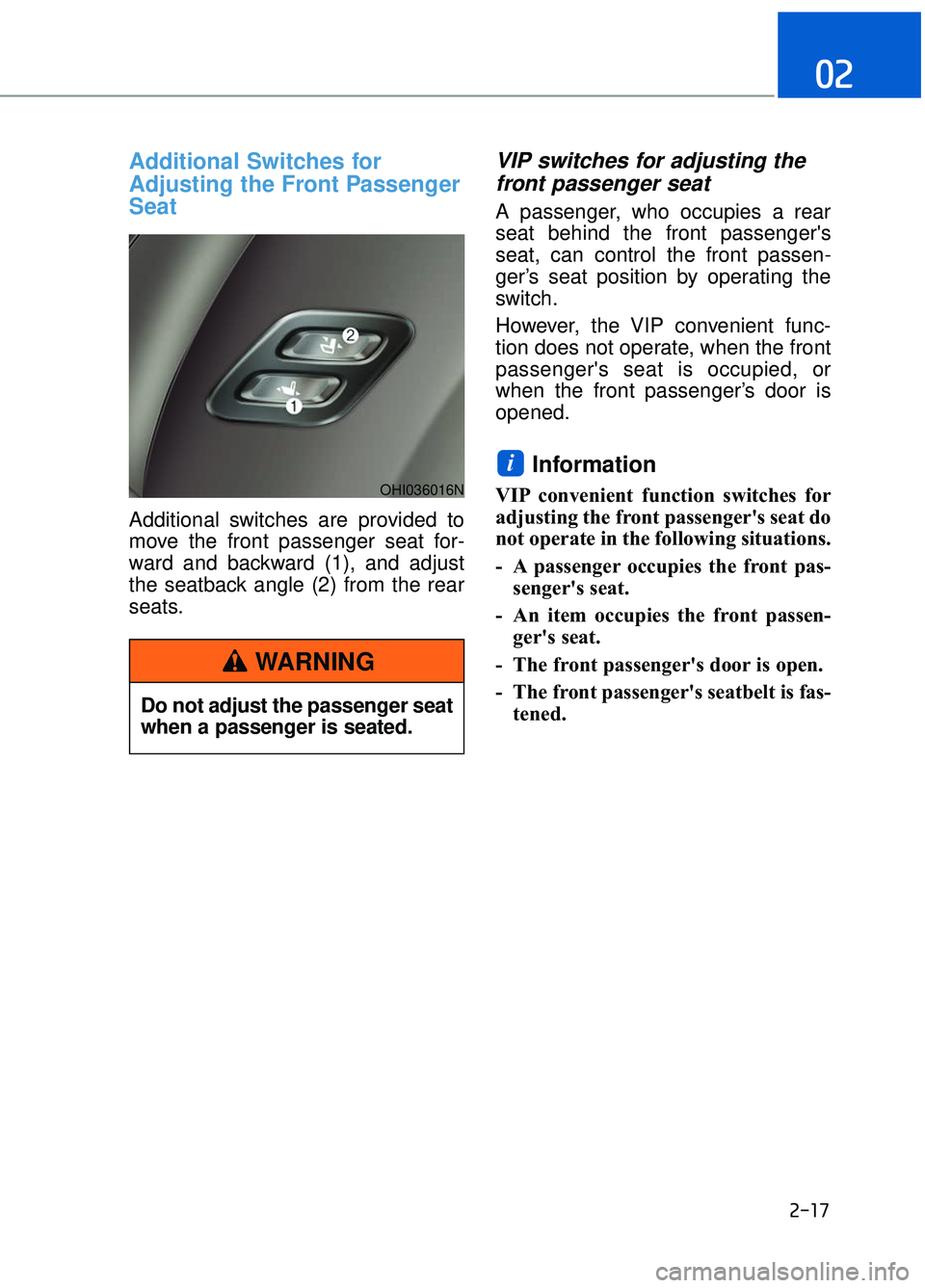
2-17
02
Additional Switches for
Adjusting the Front Passenger
Seat
Additional switches are provided to
move the front passenger seat for-
ward and backward (1), and adjust
the seatback angle (2) from the rear
seats.
VIP switches for adjusting thefront passenger seat
A passenger, who occupies a rear
seat behind the front passenger's
seat, can control the front passen-
ger’s seat position by operating the
switch.
However, the VIP convenient func-
tion does not operate, when the front
passenger's seat is occupied, or
when the front passenger’s door is
opened.
Information
VIP convenient function switches for
adjusting the front passenger's seat do
not operate in the following situations.
- A passenger occupies the front pas-
senger's seat.
- An item occupies the front passen- ger's seat.
- The front passenger's door is open.
- The front passenger's seatbelt is fas- tened.
i
OHI036016N
Do not adjust the passenger seat
when a passenger is seated.
WARNING
Page 42 of 524
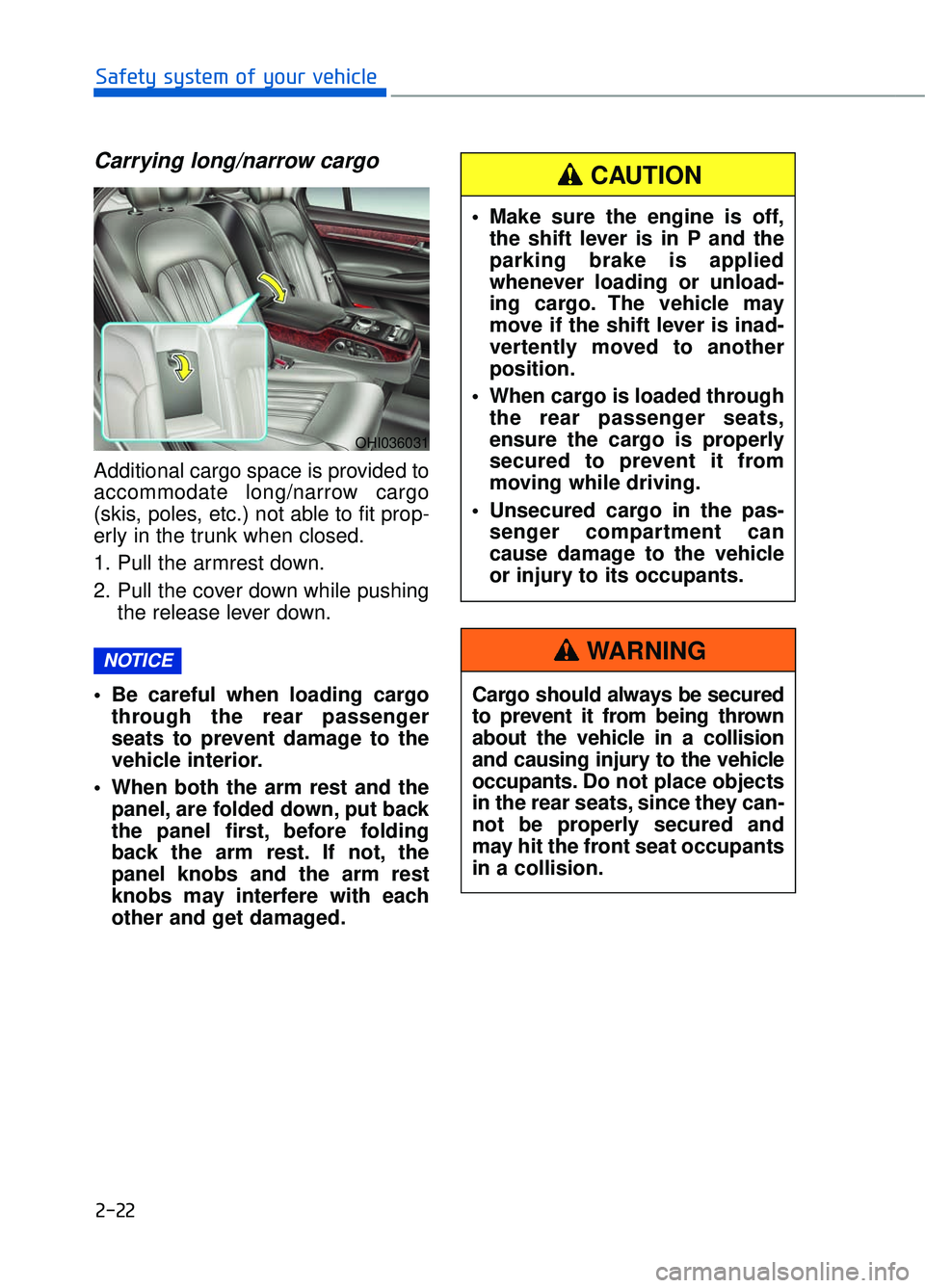
2-22
Safety system of your vehicle
Carrying long/narrow cargo
Additional cargo space is provided to
accommodate long/narrow cargo
(skis, poles, etc.) not able to fit prop-
erly in the trunk when closed.
1. Pull the armrest down.
2. Pull the cover down while pushingthe release lever down.
Be careful when loading cargo through the rear passenger
seats to prevent damage to the
vehicle interior.
When both the arm rest and the panel, are folded down, put back
the panel first, before folding
back the arm rest. If not, the
panel knobs and the arm rest
knobs may interfere with each
other and get damaged.
NOTICE
OHI036031
Cargo should always be secured
to prevent it from being thrown
about the vehicle in a collision
and causing injury to the vehicle
occupants. Do not place objects
in the rear seats, since they can-
not be properly secured and
may hit the front seat occupants
in a collision.
WARNING
Make sure the engine is off,the shift lever is in P and the
parking brake is applied
whenever loading or unload-
ing cargo. The vehicle may
move if the shift lever is inad-
vertently moved to another
position.
When cargo is loaded through the rear passenger seats,
ensure the cargo is properly
secured to prevent it from
moving while driving.
Unsecured cargo in the pas- senger compartment can
cause damage to the vehicle
or injury to its occupants.
CAUTION
Page 43 of 524

2-23
02
Head Restraints
The vehicle's front and rear seats
have adjustable head restraints. The
head restraints provide comfort for
passengers, but more importantly
they are designed to help protect
passengers from whiplash and other
neck and spinal injuries during an
accident, especially in a rear impact
collision.To prevent damage, NEVER hit or
pull on the head restraints.
NOTICE
To reduce the risk of serious
injury or death in an accident,
take the following precautions
when adjusting your head
restraints:
Always properly adjust thehead restraints for all passen-
gers BEFORE starting the
vehicle.
NEVER let anyone ride in a seat with the head restraints
removed.
(Continued)
(Continued)
Adjust the head restraints sothe middle of the head
restraint is at the same height
as the height of the top of the
eyes.
NEVER adjust the head restraint position of the dri-
ver's seat when the vehicle is
in motion.
Adjust the head restraint as close to the passenger's head
as possible. Do not use a seat
cushion that holds the body
away from the seatback.
Make sure the head restraint locks into position after
adjusting it.
WARNINGOLF034072N
When there is no occupant in
the rear seats, adjust the height
of the head restraints to the
lowest position. The rear seat
head restraints can reduce the
visibility of the rear area.
CAUTION
Page 45 of 524

2-25
02
Removal/Reinstall
To remove the head restraint:
1. Recline the seatback (2) using theseatback angle switch (1).
2. Raise the head restraint as far as it can go.
3. Insert a thin-pointed tool into the head restraint adjustment pole (3),
and then remove the head
restraint (4). To reinstall the head restraint :
1. Recline the seatback.
2. Push the head restraint height
control switch (1) up as far as it
can go.
3. Put the head restraint poles (2).
4. Adjust the head restraint to the appropriate height (3).
5. Recline the seatback (5) using the seatback angle switch (4).
OHI036011
NEVER allow anyone to travel in
a seat with the head restraint
removed.
WARNING
OHI036071
Always make sure the head
restraint locks into position
after reinstalling and adjusting
it properly.
WARNING
Page 48 of 524
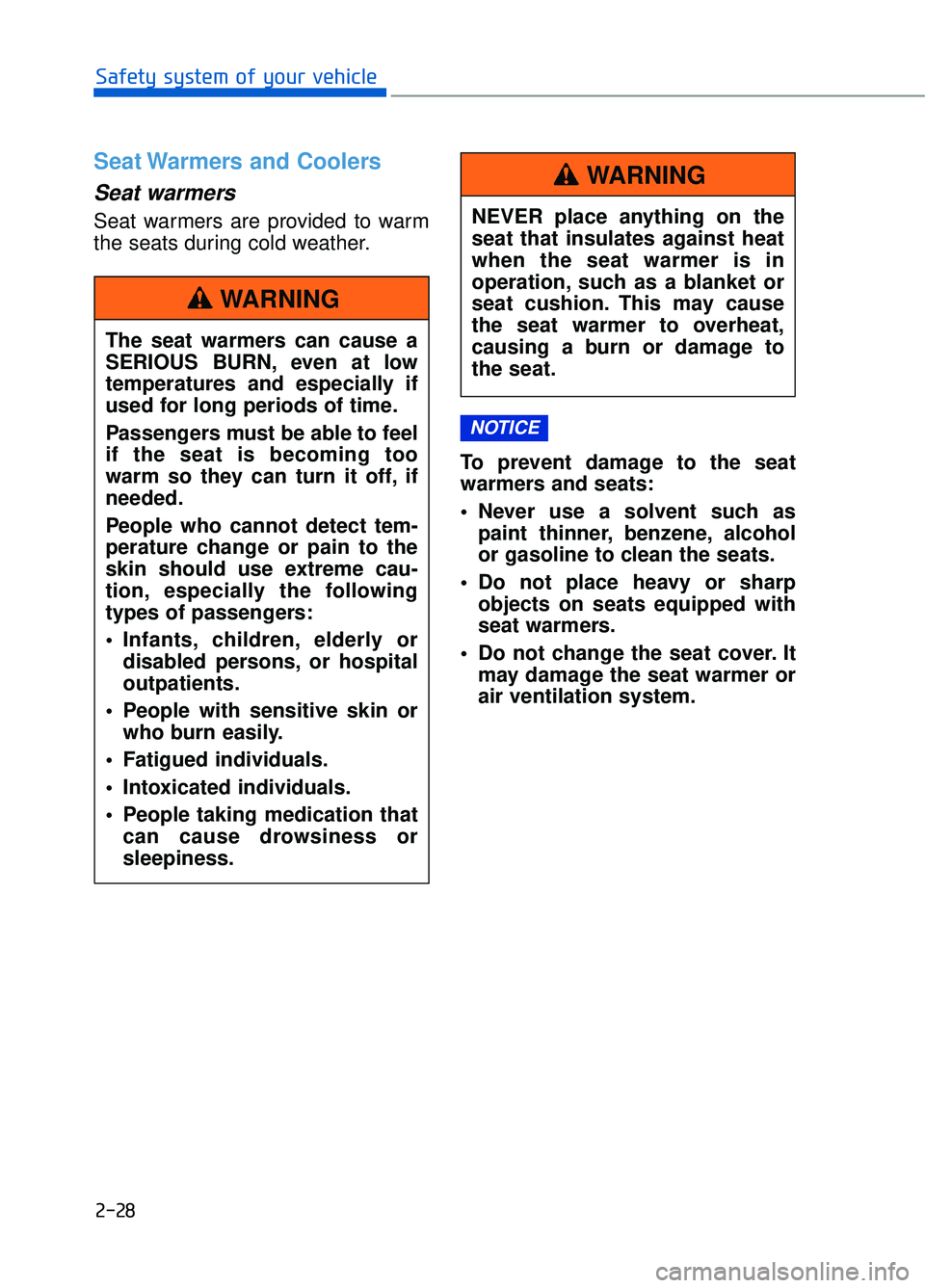
2-28
Safety system of your vehicle
Seat Warmers and Coolers
Seat warmers
Seat warmers are provided to warm
the seats during cold weather.To prevent damage to the seat
warmers and seats:
Never use a solvent such aspaint thinner, benzene, alcohol
or gasoline to clean the seats.
Do not place heavy or sharp objects on seats equipped with
seat warmers.
Do not change the seat cover. It may damage the seat warmer or
air ventilation system.
NOTICE
NEVER place anything on the
seat that insulates against heat
when the seat warmer is in
operation, such as a blanket or
seat cushion. This may cause
the seat warmer to overheat,
causing a burn or damage to
the seat.
WARNING
The seat warmers can cause a
SERIOUS BURN, even at low
temperatures and especially if
used for long periods of time.
Passengers must be able to feel
if the seat is becoming too
warm so they can turn it off, if
needed.
People who cannot detect tem-
perature change or pain to the
skin should use extreme cau-
tion, especially the following
types of passengers:
Infants, children, elderly ordisabled persons, or hospital
outpatients.
People with sensitive skin or who burn easily.
Fatigued individuals.
Intoxicated individuals.
People taking medication that can cause drowsiness or
sleepiness.
WARNING
Page 52 of 524
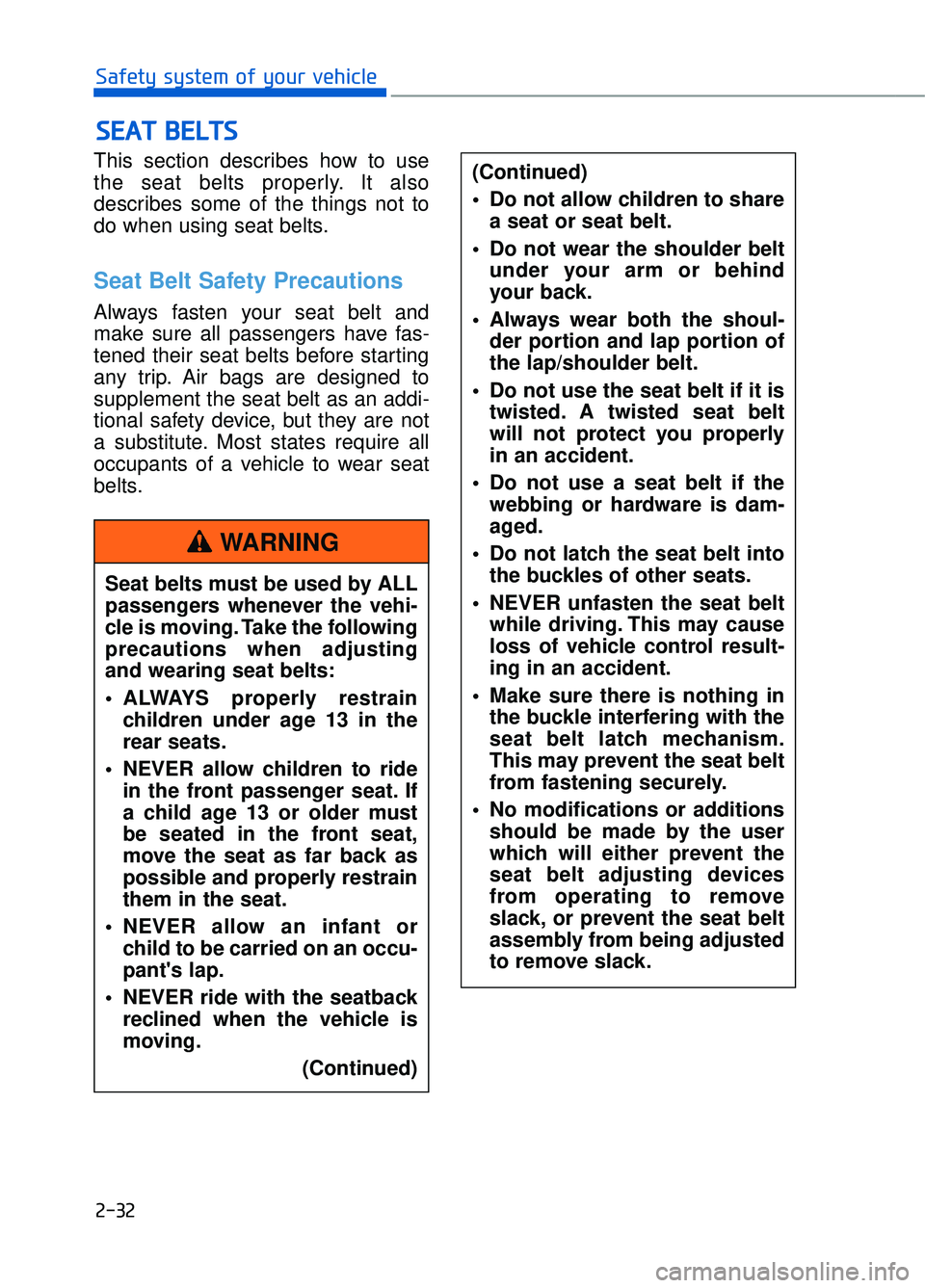
This section describes how to use
the seat belts properly. It also
describes some of the things not to
do when using seat belts.
Seat Belt Safety Precautions
Always fasten your seat belt and
make sure all passengers have fas-
tened their seat belts before starting
any trip. Air bags are designed to
supplement the seat belt as an addi-
tional safety device, but they are not
a substitute. Most states require all
occupants of a vehicle to wear seat
belts.
S SE
E A
A T
T
B
B E
EL
LT
T S
S
Seat belts must be used by ALL
passengers whenever the vehi-
cle is moving. Take the following
precautions when adjusting
and wearing seat belts:
ALWAYS properly restrain
children under age 13 in the
rear seats.
NEVER allow children to ride in the front passenger seat. If
a child age 13 or older must
be seated in the front seat,
move the seat as far back as
possible and properly restrain
them in the seat.
NEVER allow an infant or child to be carried on an occu-
pant's lap.
NEVER ride with the seatback reclined when the vehicle is
moving.
(Continued)
WARNING
2-32
Safety system of your vehicle
(Continued)
Do not allow children to sharea seat or seat belt.
Do not wear the shoulder belt under your arm or behind
your back.
Always wear both the shoul- der portion and lap portion of
the lap/shoulder belt.
Do not use the seat belt if it is twisted. A twisted seat belt
will not protect you properly
in an accident.
Do not use a seat belt if the webbing or hardware is dam-
aged.
Do not latch the seat belt into the buckles of other seats.
NEVER unfasten the seat belt while driving. This may cause
loss of vehicle control result-
ing in an accident.
Make sure there is nothing in the buckle interfering with the
seat belt latch mechanism.
This may prevent the seat belt
from fastening securely.
No modifications or additions should be made by the user
which will either prevent the
seat belt adjusting devices
from operating to remove
slack, or prevent the seat belt
assembly from being adjusted
to remove slack.